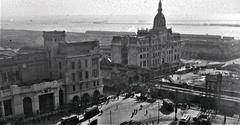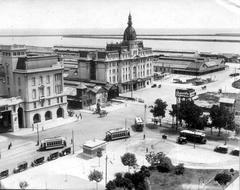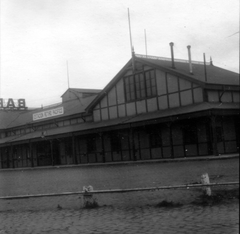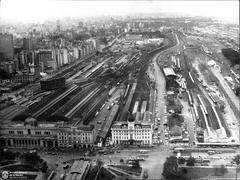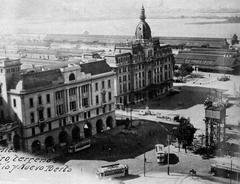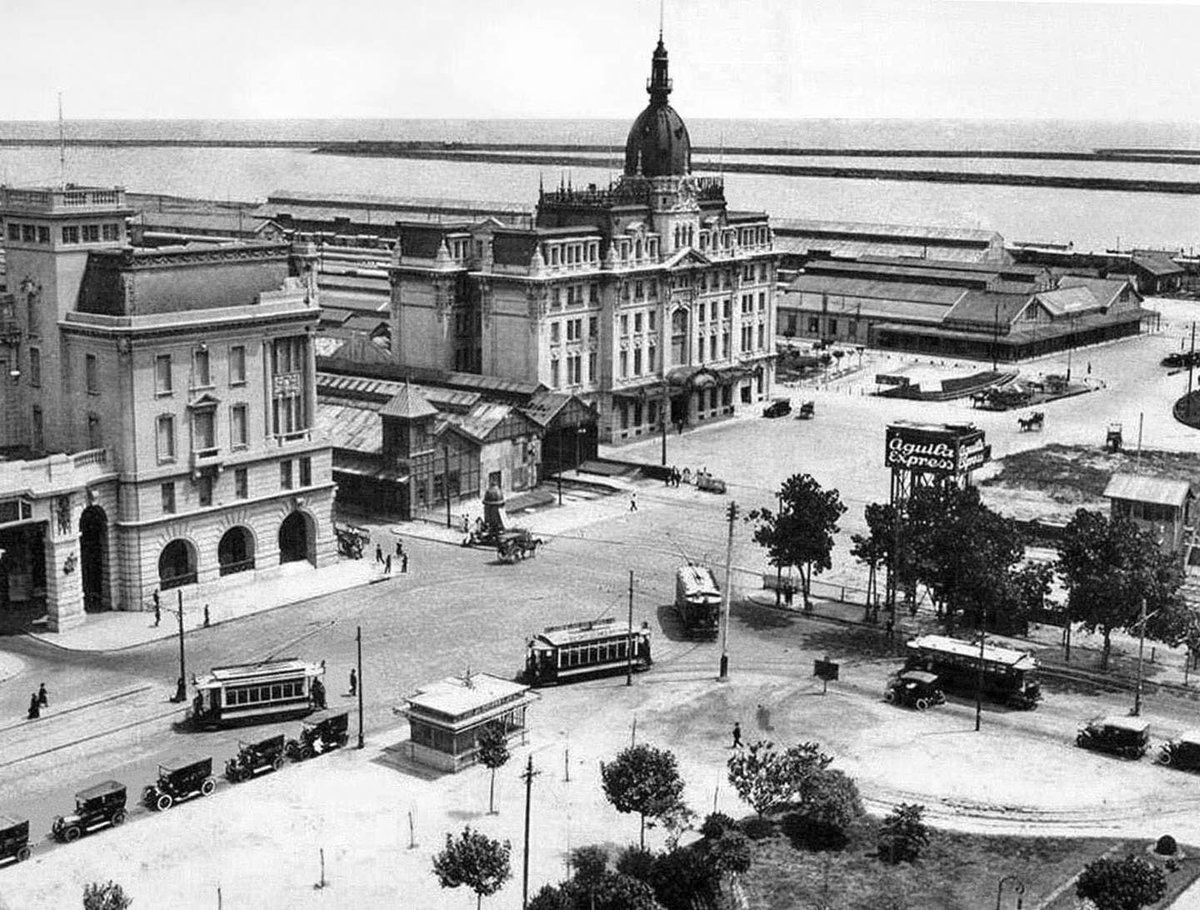
Retiro San Martín Train Station Buenos Aires: Visiting Hours, Tickets, and Travel Guide
Date: 14/06/2025
Introduction to Retiro San Martín Train Station and Its Historical Significance
Retiro San Martín Train Station stands as one of Buenos Aires’ most significant landmarks, reflecting the city’s rich past, architectural splendor, and crucial role within Argentina’s railway network. Opened in 1912, during an era of national prosperity, the station embodies British architectural influences fused with local expertise, prominently featuring Beaux-Arts and Edwardian Baroque styles. Its imposing façade, lofty ceilings, and expansive iron canopies make it a favorite destination for travelers, historians, and architecture enthusiasts alike.
Strategically positioned in the Retiro neighborhood—adjacent to Plaza San Martín and close to other major stations like Retiro Mitre and Retiro Belgrano—Retiro San Martín serves as a central multimodal hub connecting Buenos Aires to western and northwestern suburbs and provinces. The station offers modern amenities, including accessible facilities, ticket offices, and seamless integration with the city’s metro and bus systems. Its proximity to cultural attractions like Plaza San Martín and the Torre Monumental further cements its status as an ideal base for exploring Buenos Aires.
Ongoing restoration ensures that the station maintains its historic charm while catering to contemporary travel needs. In this guide, you’ll find essential information on operating hours, ticketing, accessibility, safety tips, special events, guided tours, and nearby attractions, making your visit to Retiro San Martín both smooth and rewarding.
For the latest updates, consult official sources like Trenes Argentinos and the Buenos Aires tourism portal.
Table of Contents
- Introduction
- Historical Development of Retiro San Martín Train Station
- Architectural Significance and Design Features
- Visiting Hours, Tickets, and Accessibility
- Special Events, Guided Tours, and Photographic Spots
- Nearby Attractions
- Preservation and Restoration Efforts
- Cultural and Symbolic Importance
- Visitor Experience and Architectural Highlights
- Retiro San Martín Train Station as a Transport Hub and Tourist Attraction
- Visiting Plaza San Martín and Torre Monumental in Retiro, Buenos Aires: Hours, Tickets & Tips
- Retiro San Martín Train Station: Visiting Hours, Tickets, Safety Tips & Nearby Attractions
- Introduction
- Visiting Hours and Station Access
- Station Layout and Facilities
- Retiro San Martín Tickets: Prices, Purchase, and Validity
- Connections and Accessibility
- Safety Considerations and Tips
- Practical Tips for Visitors
- Special Events and Tourist Highlights
- Nearby Attractions and Historical Sites
- How to Stay Updated
- Frequently Asked Questions (FAQ)
- Conclusion
Historical Development of Retiro San Martín Train Station
Retiro San Martín Train Station is a testament to Argentina’s modernization in the late 19th and early 20th centuries. Opened in 1912, it emerged when Argentina ranked among the world’s wealthiest nations, driven by agricultural exports and urbanization. The station anchors the Ferrocarril General San Martín line, linking Buenos Aires to the west and northwest provinces.
Located next to Buenos Aires’ central business district, Retiro San Martín played a vital role in moving people and goods, reinforcing the city’s status as the nation’s economic hub. Its establishment paralleled the construction of other major railway terminals, forming an essential transportation cluster (Go to Buenos Aires).
British involvement was pivotal in both the station’s design and financing, blending European architectural styles with local innovation. As a result, Retiro San Martín quickly became a symbol of Argentina’s modernization and cosmopolitan identity.
Architectural Significance and Design Features
Retiro San Martín’s architecture draws on Beaux-Arts and Edwardian Baroque influences, evident in its symmetrical façade, classical columns, ornate stonework, and iron detailing. The monumental entrance, grand arched windows, and vaulted ceilings create an impressive, airy atmosphere, beautifully lit by large skylights.
Iron canopies covering the platforms, supported by slender columns, showcase early 20th-century engineering prowess. The station’s layout was designed for efficient circulation, facilitating the movement of passengers and freight while preserving aesthetic appeal (Go to Buenos Aires).
Visiting Hours, Tickets, and Accessibility
- Visiting Hours: The station is open daily from 5:00 AM to 11:00 PM. Some areas’ access may depend on train schedules.
- Tickets: Purchase tickets at the station, via Trenes Argentinos, or through authorized agencies. Prices vary by destination and class.
- Accessibility: Ramps, elevators, and accessible restrooms are available. Staff assistance can be requested.
- Travel Tips: For photography and sightseeing, visit on weekday mornings or early afternoons for lighter crowds. Exercise standard urban safety precautions, especially when moving between the station and nearby areas.
Special Events, Guided Tours, and Photographic Spots
Retiro San Martín occasionally hosts cultural events and exhibitions. Guided tours, often organized by local groups or the tourism office, provide deeper insights into the station’s history and architecture (Turismo Buenos Aires).
Photographers will find excellent vantage points at the façade on Avenida Ramos Mejía, the interior tilework, platform canopies, and views across Plaza San Martín.
Nearby Attractions
Within a short walk from Retiro San Martín, explore:
- Plaza San Martín: A verdant, historic park with monuments.
- Torre Monumental: A British-built clock tower with city views.
- Puerto Madero: Waterfront district with restaurants and nightlife.
- Recoleta and Barrio Norte: Areas known for their architecture, museums, and cafés.
Use your SUBE card for easy public transport access across Buenos Aires.
Preservation and Restoration Efforts
After periods of neglect, Retiro San Martín has benefited from restoration projects aimed at preserving its historical integrity while updating facilities. Restoration has included façade cleaning, repair of decorative elements, and modernization of lighting and signage, all in line with heritage conservation guidelines (Go to Buenos Aires).
Cultural and Symbolic Importance
Retiro San Martín is more than a transport hub—it’s a symbol of progress, nostalgia, and the movement of people through time. Its proximity to diverse neighborhoods underscores Buenos Aires’ social complexity, and its grand architecture evokes the golden age of rail travel.
Visitor Experience and Architectural Highlights
Visitors can admire marble floors, stained glass, ironwork, and chandeliers throughout the station. Photography is permitted in public areas. Amenities include ticket offices, waiting rooms, restrooms, and retail outlets for traveler comfort.
Frequently Asked Questions (FAQs)
Q: What are the station’s visiting hours?
A: Open daily from 5:00 AM to 11:00 PM, subject to train schedules.
Q: How do I buy tickets?
A: Purchase online through Trenes Argentinos, at station offices, or via authorized agencies.
Q: Is the station wheelchair accessible?
A: Yes, with ramps, elevators, and accessible restrooms.
Q: Are guided tours available?
A: Occasionally, via the Buenos Aires tourism office or onsite information.
Retiro San Martín Train Station as a Transport Hub and Tourist Attraction
Strategic Location within Buenos Aires
Retiro San Martín anchors the Retiro neighborhood, adjacent to Plaza General San Martín and near the city’s major landmarks. It is one of three main stations—alongside Retiro Mitre and Retiro Belgrano—forming a key railway complex near the long-distance bus terminal (Wikipedia, Wikipedia).
Integration with Rail Services
Commuter and Suburban Rail
The station is the terminus for the San Martín Line, a commuter service connecting Buenos Aires to municipalities in the western Greater Buenos Aires area. Major stops include Palermo, Pilar, Luján, and densely populated districts such as Tres de Febrero, Morón, Hurlingham, San Miguel, and José C. Paz (Horariomundo). The platforms’ iron structure stands as a testament to early 20th-century ambition (Turismo Buenos Aires).
Long-Distance and National Rail
Historically, Retiro San Martín was the departure point for trains to San Luis, Mendoza, San Juan, and beyond. Today, it remains the starting point for trains to Rufino and other regional destinations, operated by Trenes Argentinos (Wikipedia).
Multimodal Connectivity
Metro (Subte) Access
Direct access to Subte Line C, with further planned extensions of Lines E and H, ensures easy city-wide connectivity (Metrolinemap).
Bus and Coach Services
The adjacent Retiro Bus Terminal offers long-distance and local coach services, connecting to cities nationwide and within Buenos Aires (Wikipedia).
Facilities and Passenger Services
Ticketing, Visiting Hours, and SUBE Card Access
The station operates from 5:00 AM to 11:00 PM. Commuter train fares are affordable (ARS 7–20), with tickets available at counters or vending machines. The SUBE card is essential for public transport and can be purchased/recharged at the station with a passport (The Thorough Tripper).
Amenities and Accessibility
Expect comfortable waiting areas, restrooms, cafes, and shops. Restoration projects have updated facilities while retaining historic features (Turismo Buenos Aires). Ramps and elevators ensure accessibility, though staff may not speak English fluently (The Thorough Tripper).
Urban and Social Context
Proximity to Key Districts and Historical Sites
Retiro San Martín’s position allows easy exploration of Microcentro, Recoleta, Teatro Colón, Torre Monumental, and Plaza General San Martín (Introducing Buenos Aires).
Social Contrasts
The nearby Villa 31 informal settlement is not recommended for tourists but underscores the city’s social contrasts (Introducing Buenos Aires).
Operational Significance and Daily Impact
Passenger Volume and Frequency
The San Martín Line is integral for thousands of commuters daily, with frequent departures and ongoing improvements to enhance service (Horariomundo).
Economic and Urban Development
The station’s presence supports commercial activity and urban growth, contributing to the neighborhood’s vibrancy (Dazzler San Martín).
Practical Tips for Tourists
- Navigation: Signage is clear, but allow extra time during rush hours.
- Safety: The station is generally safe, but remain vigilant and avoid Villa 31.
- Transport Integration: The SUBE card is a must for multi-modal travel (The Thorough Tripper).
- Nearby Attractions: Visit Plaza General San Martín, Torre Monumental, and local museums.
Plaza San Martín and Torre Monumental: Visiting Hours, Tickets, and Tips
Plaza San Martín
- About: A lush urban park with monuments, including the statue of General José de San Martín.
- Hours: Open daily 6:00 AM–10:00 PM, free entry.
- Accessibility: Wheelchair accessible, with paved walkways and nearby public transport.
- Tips: Visit in the morning or late afternoon for the best experience and photography.
Torre Monumental
- About: A historic clock tower gifted by the British community.
- Visiting Hours: Tuesday to Sunday, 10:00 AM–6:00 PM; closed Mondays and public holidays.
- Tickets: Around ARS 100, available on-site or via Buenos Aires Tourism.
- Accessibility: Elevator to observation deck; partial accessibility for reduced mobility.
- Tips: Visit on clear days for panoramic views, and check for guided tours.
How to Get There
- Both landmarks are within walking distance of Retiro San Martín.
- Accessible via Retiro train and bus stations, and Metro Lines C and D.
- Taxis/rideshares are recommended at night.
Other Nearby Attractions
- Kavanagh Building (Art Deco icon)
- Patio Bullrich and Galerías Pacífico (shopping centers)
- Plaza Fuerza Aérea Argentina (public park)
Photography and Interactive Experiences
Both sites offer excellent photo opportunities. Interactive maps are available via the Audiala app.
Retiro San Martín Train Station: Visiting Hours, Tickets, Safety Tips & Nearby Attractions
Visiting Hours and Station Access
The station typically operates from 5:00 AM–11:00 PM. Check digital boards or official sources for updates.
Station Layout and Facilities
Retiro San Martín features high ceilings, bright halls, and facilities such as:
- Ticket Counters/Machines: Blue lights indicate open booths (argentinamo.com).
- Digital Departure Boards: Real-time updates.
- Kiosks and Cafés: For snacks and drinks.
- Restrooms and Lockers: Secure luggage storage.
- ATMs: Fees may apply; use with caution.
- Police Post: Visible security presence.
Tickets: Prices, Purchase, and Validity
- Ticket Prices: Affordable; similar to metro/bus fares.
- Payment: Cash (ARS), local debit cards; international cards may not always work.
- Ticket Validity: For specific trains/dates only.
- Bicycles: Allowed on trains.
Connections and Accessibility
- Metro (Subte) Line C: Direct access.
- Bus Terminal: For regional/national travel.
- Other Train Lines: Retiro Mitre/Belgrano nearby.
- Accessibility: Ramps, elevators, tactile markings, and accessible restrooms.
Safety Considerations and Tips
While generally safe, exercise caution:
- Risks: Pickpocketing and “motochorros” (motorcycle snatch thefts).
- Tips: Keep valuables secure, avoid distractions, travel in groups at night, and stay away from unsafe areas (secretsofbuenosaires.com).
- Emergency: Police post onsite; dial 911 for emergencies.
Practical Tips
- Plan Ahead: Check schedules and hours.
- Arrive Early: Especially during peak times.
- Language: Basic Spanish is useful.
- Wi-Fi: Often unreliable; consider a local SIM.
- Luggage: Use lockers as needed.
Special Events and Highlights
Occasional cultural events and photo opportunities occur; check with local tourism offices for details.
Nearby Attractions
- Plaza San Martín
- Torre Monumental
- Monument to General San Martín
- Centro Naval and Palacio Haedo
How to Stay Updated
Download the Audiala app or follow official Buenos Aires transport channels for updates.
Summary of Key Visitor Information and Tips
Retiro San Martín Train Station remains a pillar of Buenos Aires’ urban landscape, blending historical grandeur with modern transit functions. Its architectural beauty, daily operations, and accessibility serve thousands of travelers while reinforcing the city’s economic and cultural significance. Located near major landmarks, the station offers a rewarding entry point for exploring Buenos Aires. Remain aware of safety guidelines, leverage ongoing restoration efforts, and utilize helpful travel tools like the Audiala app for a seamless experience.
For detailed planning, refer to Retiro San Martín on Turismo Buenos Aires and other official resources (Go to Buenos Aires).
References and Further Reading
- Retiro San Martín Train Station: Visiting Hours, Tickets, and Historical Highlights in Buenos Aires (Go to Buenos Aires)
- Retiro San Martín Train Station as a Transport Hub and Tourist Attraction, Wikipedia (Wikipedia)
- Horariomundo - San Martín Line Schedules (Horariomundo)
- Turismo Buenos Aires - Retiro Station (Turismo Buenos Aires)
- The Thorough Tripper - Buenos Aires Travel Tips (The Thorough Tripper)
- Metrolinemap - Buenos Aires Metro Stations (Metrolinemap)
- Introducing Buenos Aires - Retiro Neighborhood (Introducing Buenos Aires)
- Dazzler San Martín - Retiro Neighborhood Overview (Dazzler San Martín)
- Visiting Plaza San Martín and Torre Monumental in Retiro, Buenos Aires (Turismo Buenos Aires)
- Argentinamo - Retiro Train Station Guide (argentinamo.com)
- SecretsofBuenosAires - Safety in Buenos Aires (secretsofbuenosaires.com)

